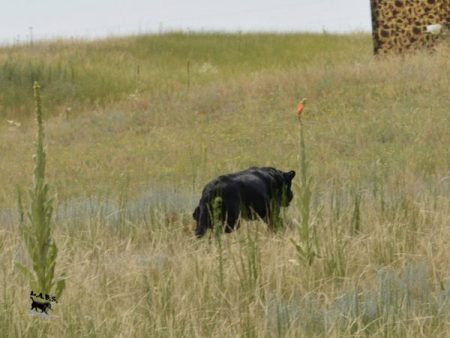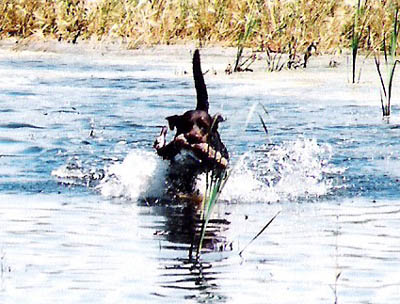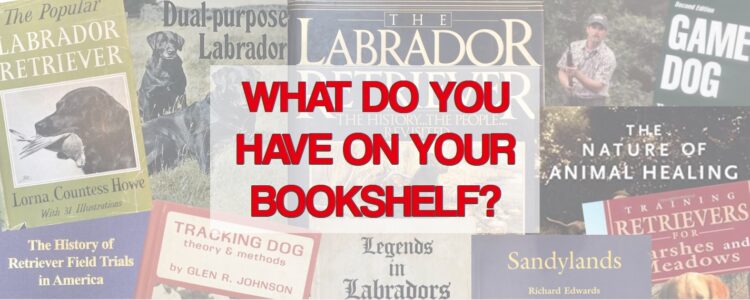
I was dusting my shelves and noticed I have a LOT of books about dogs in general and Labradors in particular. My library isn’t limited to Labs, but also includes books on other breeds, plus books on training, care, and breeding. Here’s a list to help you decide what books you need in your library.
Labrador history
The Labrador Dog – Its Home and History (1936)
– Lord George Scott and Sir John Middleton
This is one of my favorite books! It was written by Lord George Scott, brother of the 7th Duke of Buccleuch, and Sir John Middleton, the former Governor of Newfoundland. Lots of early history! Although the book’s cover isn’t in great shape, the interior is well preserved. Even the fold-out pedigrees on tissue paper are intact.
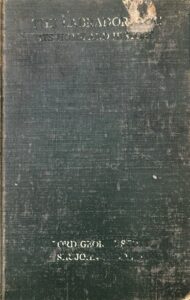
The Popular Labrador Retriever
– Lorna, Countess Howe
It’s a typical dog book, but having been written by one of the greatest proponents of the breed makes it special. She knew many of the early breeders and their dogs, often buying the best dogs she found. She wrote of the founding of the breed, the early dogs and their breeders. A story she included was about Lord Knutsford (then the Hon. Arthur Holland-Hibbert). He wanted to import a dog to add to his Munden strain and asked a friend for help. His friend didn’t find a dog, but was told “You will get a better one nearer home from a young fellow called Holland-Hibbert who lives at Munden, Hertfordshire.”
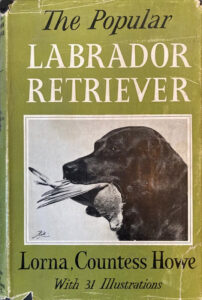
The Labrador Retriever – The History, The People
– Richard A Wolters
A comprehensive book about the Labrador Retriever. It starts with a detailed dive into the beginning of the breed based on the author’s review of early sources. He explains what sources he used and how they fit together, but it’s still like a jigsaw puzzle with some pieces missing. He continues onward discussing the Lab’s journey to England and Scotland, plus the times the breed nearly ended. Then the export to the US and breeders such as Jay Carlisle of Wingan put Labs on the path to popularity.
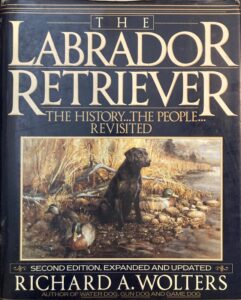
Other Labrador Retriever topics
The Dual-Purpose Labrador
– Mary Roslin-Williams
This book was published in 1969 by a woman who knew Labradors. Any book by MRW is worth reading and this one doesn’t disappoint. If you can find a copy available, snap it up. Then be sure to read the chapters on Type and Conformation. You may also want to listen to one of her lectures as well.
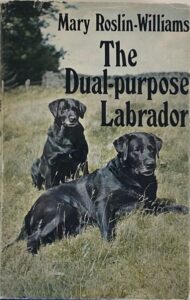
Reaching for the Stars
– Mary Roslin-Williams
Previously titled Advanced Labrador Breeding, this book is all about breeding. She discusses successful breeders and the qualities that make a good breeder. The part I found most interesting was her description of the stages a breeder goes through.
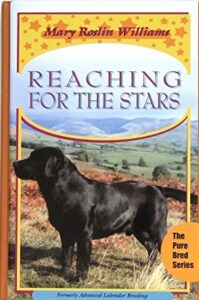
Legends in Labradors
– Nancy Martin
The author visited many important breeders, both in the UK and the US, and wrote a series of profiles. Included are Sandringham, Banchory, Ballyduff, Blaircourt, Cornlands, Hiwood, Knaith, Mansergh, Sandylands, and more from the UK. Plus Arden, Chidley, Deercreek, Earlsmoor, Franklin, Lockerbie, Nilo, Whygin, Wingan, and others from the US. The profiles aren’t long or in depth, but they give you a taste of why these kennels were so important.
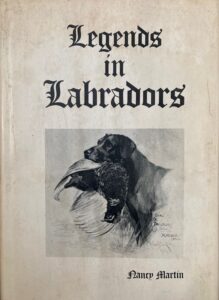
The Book of the Labrador Retriever
– Anna K. Nicholas
Starts by discussing the origins and standards of the breed, and provides advice on caring for, showing, and obedience training Labradors. But what sets it apart from many breed books is the information on kennels in the US and Canada. Kennels included Beechcroft, Broad Reach, Campbellcroft, Chidley, Finchfield, Franklin, Killingworth, Kimvalley, Lockerbie, Mandigo, Rupert, Scrimshaw, Shamrock Acres, Simerdown, and Whygin.
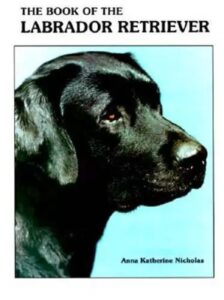
The Official Book of the Labrador Retriever
– Labrador Retriever Club Inc
Another comprehensive book about Labradors, although not so deep as Richard Wolters’ book, The Labrador Retriever. It has a section on history of the breed, but more interesting are the pedigrees and photos of Labs. Many of the highlighted bloodlines are from Europe and especially England and Scotland.
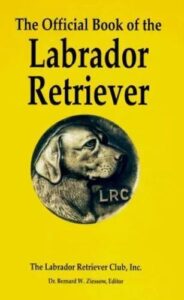
The Complete Labrador Retriever
– Helen Warwick
A lovely book that lives up to its name. If you want to learn about Labrador Retrievers – albeit at a high level rather than a deep dive – this is the book for you. Mrs. Warwick does a good job condensing the Lab’s history and yet keeping it readable. Other chapters discuss yellows and chocolates, Labs in other countries, showing, and breeding.
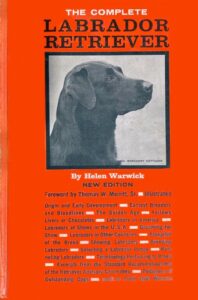
The Ultimate Labrador Retriever
– Heather Wiles-Fone
This is a large book with each chapter penned by an authority on that topic. Learn about Lab history, raising a puppy, training, showing, breeding, health, and more. And each chapter is complete enough to be its own book.
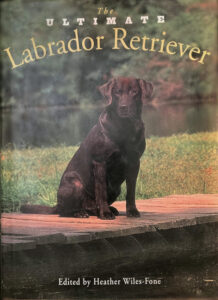
Sandylands
– Richard Edwards
A very in depth book about the Sandyland dogs – mostly Labradors, but also some other breeds. Follow along as Labs twine through Gwen Broadley’s life, from Juno through Tandy, Tweed, Mark, and many others. If you have any questions, the author is active on Facebook. And he also wrote a chapter in The Ultimate Labrador Retriever as did Marjorie Satterthwaite.
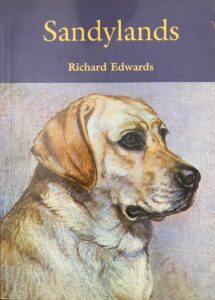
The Retriever Owner’s Encyclopedia
– Gwen Broadley
I stumbled upon this book recently and bought it because the author bred so many wonderful dogs under the Sandylands name. The book is more of a dictionary of dog terms, some simple and other lesser known terms such as haw, eclampsia, and timber. What I liked best was the sprinkling of photos including Sandylands Tweed of Blaircourt, Sandylands Tandy, Lockerbie Kismet, Knaith Banjo, and Reanacre Mallurd Thunder retrieving a fox. Although most of the photos are of Labs, there are also some of Goldens, Flatcoats, and Curly Coated dogs too.
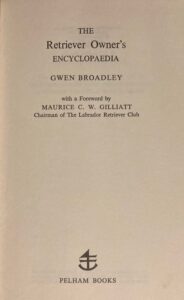
The Labrador Retriever
– David D Elliot
Numbered edition, mine is #18
A little book with basic Labrador care instructions, but what sets it apart are the number of photos of dogs from the Wingan kennel. Mr. Carlisle did an awesome job importing and breeding the best Labs. He was also very giving with his time to help other breeders. When he died he left his dogs to his trainer, David Elliot.
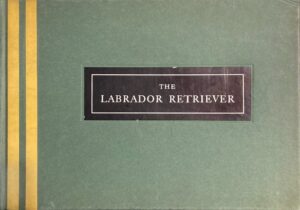
Life Magazine, Issue December 12, 1936
This issue included an article about Blind of Arden with an arresting photo of him on the cover. The article talked about his win at the “No. 1 U.S. Retriever Test” and included several photos. At that time, Labs were still new to the US.
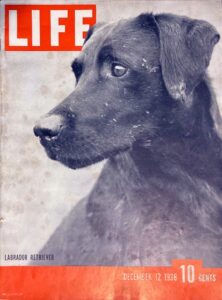
A Dog Owner’s Guide to Labrador Retrievers
– Marjorie Satterthwaite
This is a nice little introduction to Labs book, but I bought it for sentimental reasons. I met and talked with Mrs. Satterthwaite at the 2004 LRC National Specialty. She said some nice things as she went over my dog, even though we both knew Arwen wasn’t a show dog. We talked again at the hunt test when I gave her a photo of her judging my friend’s dog the day before. She passed away just a few years later.

Health
The Nature of Animal Healing
– Dr. Martin Goldstein
I got to meet Dr. Marty when he was on his book tour. He’s such an inspiration! In his book he gives several ways to help your dog live longer and healthier. If you want to jump right into raw feeding, he tells you how to do it. Not quite ready to go all the way? He has tips to ease into it. I eased in because it’s hard to give your dog raw meat – bone and all – and wonder if it’s safe. But they loved it and I got over being fearful (mostly). I also think it helped my chocolate Lab live to 17 years old.

Keep Your Dog Healthy the Natural Way
– Pat Lazarus
This book is similar in many ways to The Nature of Animal Healing. It talks about feeding a natural diet and gives variations for females in whelp and another for puppies. Plus it explains why a natural diet is better. It also covers alternatives to vaccinations and the benefits of alternative medicine such as chiropractic, acupuncture and homeopathy.

Field training and history
History of Retriever Field Trials in America
– Fred Kampo and Carolyn McCreesh
A signed, limited edition book that looks great on the coffee table. More than that it provides a detailed glimpse into the start of field trialing in the US. It includes information about the dogs’ performances, the handlers and owners, and the estates where trials were held. I love the amount of photos included and the depth of detail. However I wish that sub-headings had been used to make it easier to find specific information.
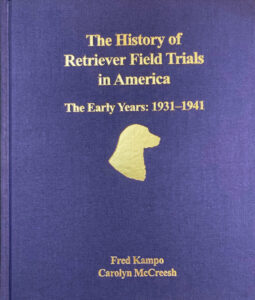
Mike Lardy’s training articles
– Collections 1 & 2
Collections of articles written by one of the most successful field trial trainers. Covers basic training through blinds, although it’s not very detailed. I recommend getting the first collection to get a good overview on field training. He also offers various videos that are more expensive, but can be a great help if you learn better visually. Most trainers I know use Lardy’s training progression or something very similar. Available through Total Retriever Training along with several great videos/DVDs.
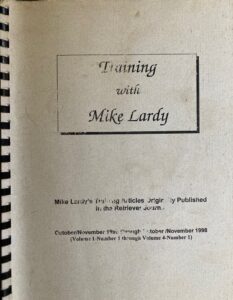
Tri-Tronics Retriever Training
– Jim & Phyllis Dobbs
Step-by-step program for retriever training which emphasizes “making it easy for dogs to learn.” Excellent section on the use of the electronic collar. There are also some concepts gathered from Schutzhund training. By the way, if you use Lardy’s program, skip this book or vice-versa. Trying to use both will confuse your dog.
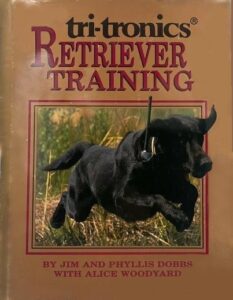
Training Retrievers for the Marshes and Meadows
– James B Spencer
A rather chatty book that starts with choosing a puppy and works its way through beginning to advanced blinds and marks. It does work, but you might want to pick up his other books that go into more detail on marking and running blinds.

Training Retrievers to Handle
– DL & Ann Walters
Very in depth book, but worth reading to understand the steps involved in teaching a dog to handle.
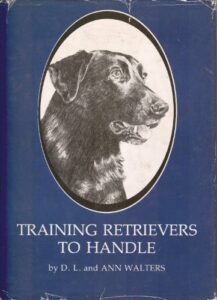
Retriever Training Drills for Marking
– James B Spencer
Because we can’t have a chat with our dogs and explain what we want – in a way they understand – we need drills. Some drills help teach a skill, others are used to refine a behavior. Drills are introduced during basics training and repeated over several training sessions. This book includes a variety of drills to help dogs pinpoint the area of the fall and go straight there.

Retriever Training Drills for Blind Retrieves
– James B Spencer
Most drills have been developed by pros who need ways to teach dogs a concept. Some drills have been shared, while other drills have stayed within a group of people. For example, wagon wheel and 3-hand casting drills are well known. This book does a deep dive into a variety of drills including the purpose of the drill, equipment needed, precautions to take, and a step-by-step description.
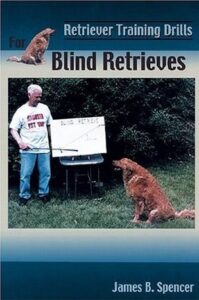
Retriever Training Tests
– James B Spencer
I wish more judges would read this book. Some judges have never hunted which leaves them at a disadvantage. They compensate by setting up a test similar to what they’ve seen as a competitor. Unfortunately they often don’t understand the ‘why’ of that set up. Other judges have lots of hunting experience which really helps them set up a realistic test. Sometimes, however, what happens in an actual hunt doesn’t transfer well to a testing environment.
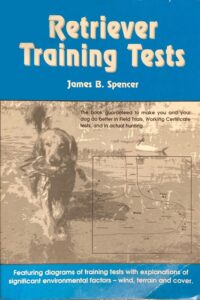
Water Dog
– Richard Wolters
A classic! Many dogs have been trained using this book, however there are newer books available. I think some of the new techniques are easier for the dogs to learn.
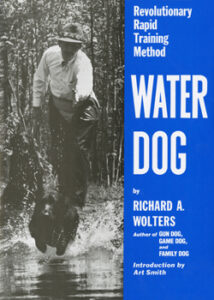
Game Dog
– Richard Wolters
Another good book and similar to Water Dog, but it focuses more on training for upland hunting. I like that it has a step-by-step method.
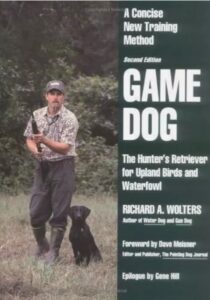
Other dog training books
Expert Obedience Training for Dogs
– Winifred G. Strickland
I have a couple of Bill Koehler’s books and his methods work. However I like more of a partnership rather than a master and servant relationship. Mrs. Strickland worked with her dogs and developed top obedience competitors that were happy and enthusiastic in their work. It also includes how to train tricks and basic tracking.
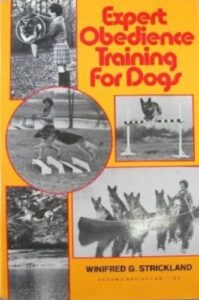
Peak Performance
– M. Christine Zink DVM
How to keep dogs fit and active by a consultant on canine sports medicine. Owners should learn their dogs’ health needs and how to keep them fit to compete successfully.

Beyond Basic Dog Training
– Diane L Bauman
A more recent book on obedience training that allows dogs to learn by trial and error. The dog isn’t corrected and so isn’t afraid of failing. I’ve heard many obedience trial champions have been trained using this method.
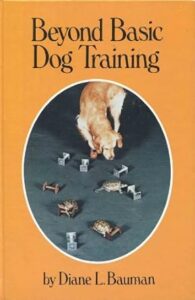
Tracking Dog Theory & Methods
– Glen R. Johnson
An oldie, but if you follow his methods your dog should be ready to run a TD test in about two months. It’s the best all-around book for understanding how to train a dog to track. It includes a schedule to train for TD and TDX titles, although it doesn’t include any information about the VST title.
Component Training For Variable Surface Tracking
– Ed Presnall and Christy Bergeon
Breaks down training for VST into specific skills. Not particularly easy to read, but it is the best book available on VST training.
Other books you need
The New Art of Breeding Better Dogs
– Kyle Onstott
This book does a good job of explaining how to combine genes to create a better dog. It includes an excellent chapter on inbreeding, line breeding, and outcrossing.
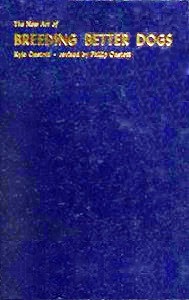
The New Knowledge of Dog Behavior
– Clarence Pfaffenberger
Research on how and when puppies are socialized makes a big difference in how well they can adapt to life with people. This led to discovering the critical stages of puppy development. If that time is missed the puppies may never be able to bond with people.
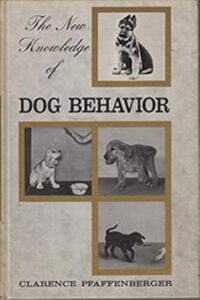
I also have a lot of yearbooks and compilations:
The Labrador Retriever Club (UK) Stud Book and Record of Field Trials 1949 – with an introduction by Lorna, Countess Howe
The Labrador Retriever Club 1931-1956
The Handbook of Amateur Retriever Trials, 1951-1961
Labrador Retriever Bench Records, 1967-1983
Retriever Field Trial Performances (I have almost all volumes, although I’m still looking for the 1979-1984 edition and volumes from 2009 forward.)
Some of the books are rather old and out of date, but there’s still good information in them. Just don’t get me started on magazine collections!
What are YOUR favorite dog books?
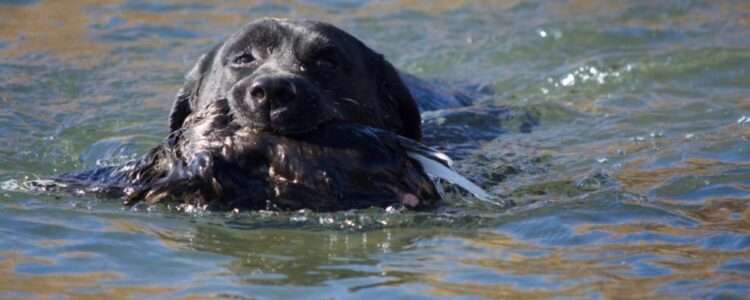
After a rewarding hunting season, you might find yourself looking for more challenges and opportunities to bond with your dog. That’s where hunting tests come into play.
Some hunters may feel their dogs are skilled enough without needing titles and ribbons, but hunting tests offer much more.
It’s a great way to keep your dog active and in sync during the off-season. Plus, it’s an opportunity to showcase your dog’s abilities and to connect with others who share the same passion. Many lifelong friendships are forged while training and competing.
With your curiosity piqued, I’ll bet you’re wondering, “What can I expect at a hunting test?” Well, grab your favorite beverage and settle in to learn about the fascinating world of retriever hunting tests.
History of Retriever Hunting Tests
Retriever breeds have competed in field trials in the US since the 1930s. In the beginning, the tasks required of the dogs were not much different than we see in hunting tests today. But as the dogs got better, the tasks got harder. And as the tasks got harder they became less like hunting.
Eventually, hunters wanted a way to test their dogs’ actual hunting abilities. A few different programs were tried but with little success.
Then in 1979, Omar Driskill started a “gun dog club” in Louisiana that became very popular. A few years later Bill Tarrant noted field trials were producing dogs that were different than what the average hunter wanted. And Richard Wolters (author of “Water Dog”) wrote an article asking if there’s a need for the hunting retriever movement.
Table of Contents
History of Retriever Hunting Tests
The Basics of Retriever Hunting Tests
Junior vs Started Retriever Hunting Tests
Senior vs Seasoned Retriever Hunting Tests
Master vs Finished Retriever Hunting Tests
Master National vs International Grand Hunt
So hunting enthusiasts got together in New York to discuss forming an organization for hunting retrievers. Present were trainers, writers, and representatives from AKC and UKC.
First Hunting Tests
Based on that meeting, the first hunting test was held in 1983 under the North American Hunting Retriever Association (“NAHRA”) rules.
About a year later the Hunting Retriever Club (“HRC”) was formed. Shortly after that the American Kennel Club (“AKC”) held its first retriever hunting test. Because of their common start, the rules and the stakes offered are very similar. The tests are not competitive so the dogs pass or fail on their own merits. There are three basic levels with titles in each organization.
In 1985, the first year that AKC licensed tests, there were 13 events with 681 entries. By 2005, there were 341 events with nearly 35,000 entries.
It wasn’t long before owners who had titled their dogs in Master or Finished, wanted something more to achieve. This led to the development of the Master National (affiliated with AKC) and HRC’s International Grand.
Something the original organizers probably didn’t consider was as training methods improved the tests would gradually became more difficult. A Junior stake 20 years ago was very different from tests today despite the rules changing very little. This seems to be the case in both organizations, but it’s a bit more apparent in AKC tests.
The Basics of Retriever Hunting Tests
The AKC and the HRC offer similar hunting tests. Each offers three levels for weekend hunt tests, plus a more difficult annual (twice annually for HRC) test. HRC also offers an Upland test.
Clothing
AKC requires handlers to wear “dark or customary hunting attire”.
HRC requires the handler to wear ALL camouflage – shirt with pants / shorts / or skirt. Hats and waders, if worn, also need to be camo.
Titles
Titles earned in AKC hunt tests are listed after the dog’s name, while HRC titles are listed before the name.
The levels are:
| AKC | HRC |
| Junior / JH | Started / SHR |
| Senior / SH | Seasoned / HR |
| Master / MH | Finished / HRCH |
| Upland / UH | |
| Master National / MNH | International Grand / GRHRC |
The rules are similar, but not exactly the same. Be sure to check before entering and running your dog. You should read the rule book and highlight important information so you can find it easily when you have questions.
Allowed breeds:
You’d think retriever hunt tests would be for retrievers, but both organizations opened the tests up to many hunting breeds. In a nutshell, they allow retrievers, plus Standard Poodles and a variety of spaniel and pointer breeds.
Spayed/neutered dogs and dogs that would be disqualified in the show ring are also welcome.
AKC restricts the hunt tests to dogs over six months, individually registered (not just litter registration), and of eligible breeds. There are special rules for entering imported dogs that are not yet registered with AKC.
HRC limits the tests to hunting breeds on their list which does not include dilutes (the “Silver Labs“). Note: if a dilute dog is entered in a hunting test the test committee should be notified. HRC does not consider dilutes a hunting breed and are disqualified.
Joining a club
You don’t have to be a member of a club to enter, but having a group to train with can be helpful.
Find a local AKC club (select ‘Hunting Test’ and your state)
Find a local HRC club (click on ‘State’ to group clubs by state)
Join HRC (national club) It’s not expensive and you get an informational magazine six times per year. There are additional fees in HRC if you are not a member of the national club or if your dog is not UKC registered.
Click to start the UKC registration process. If your dog is AKC registered, have that information handy to fill out the UKC form.

Click to watch a video of Omar Driskill talking about the start of hunt tests.
Junior vs Started Hunting Tests
The Junior and Started hunting tests are very similar. They include two series – a land series with two single retrieves on land and a water series with two single retrieves on water.
Both allow you to hold your dog at the line. In Junior, you can loop a slipcord through the collar which must be a flat buckle collar. Or you can hold the dog by the collar. In Started, you can hold the dog by a collar, leash, or line around its neck. (As a judge, I always recommend holding your dog. If you don’t and your dog breaks, he will likely fail.)
A change in AKC rules as of August 1, 2023 allows handlers to speak quietly to their dog and be allowed to touch their dog for reassurance or positioning. This is only allowed at the Junior level. Handlers can speak quietly to their dog in Started as well.
You don’t handle a gun in AKC and rarely handle one in HRC. Although in HRC you can opt to shoulder and shoot a popper. However in that case you cannot hold your dog and you are also judged on gun safety.
There are some differences
You’ll need a whistle in either test and a duck call in Started. Although the AKC premium usually says to bring a duck call, many judges don’t require it. You should, however, have your own duck call, know how to blow it, and have your dog used to it. Just in case.
Distances
The maximum distances are different. In Junior, the test distance on land and water “should not normally exceed 100 yards.” But in Started, the “maximum land test distance will not exceed seventy-five (75) yards, but may be less.” The wording is the same for water, but the maximum distance is 60 yards. Some judges like to push the distance out further, particularly in AKC where the wording is not as definite.
Sit or Stand
You’ll often stand beside your dog in Junior. Whereas in Started you’ll generally sit on a bucket beside your dog. Be prepared to run your dog from either position.
Entry Limits
Started is limited to 50 entries per flight. Most HRC Started tests don’t fill, but enter as soon as entries open if you want to be sure. Many clubs allow “walk ups” (entering the morning of the test), but only until the limit is reached. Junior entries are rarely limited, however entries are only accepted until about two weeks before the test.
Birds
Ducks are often used, but occasionally you’ll see a mixed bag of ducks on water and upland birds on land.
In Junior, you’ll have at least one shot flyer (unless using live ammunition is prohibited by law or the land owner). A live bird will be thrown in the air and shot. Depending on the gunners, that could mean a dead bird, a lightly-hit runner, or a hard-hit bird not be suitable for the table.
In Started the birds are usually humanely killed on the morning of the hunt test. Often gas is used and new dogs can be unsure of that smell, but the scent wears off quickly. If your dog has never run an HRC test, you can ask to run a bit later.
After the bird lands you must wait for the judge to release you in a Junior test.
But in Started, you’re allowed to send your dog as soon as the bird hits the ground or water. However, you should wait a couple of seconds so there’s no question the bird landed before you sent your dog.
Confusion
Sometimes a dog will start toward a mark and stop within about 15 feet. In Junior, the dog can be recast because he may be confused whether he was actually sent to retrieve. This is different from a dog that goes to the area of the fall, fails to find the bird, and comes back to the handler. However in Started you can cast your dog a maximum of two times from the line per bird. The rules don’t specify a limit on how far the dog can go or how long he can hunt.
Delivery
Your dog must deliver all birds to hand in Junior. If he drops it, perhaps to shake off water, you can tell him again to fetch it. You may have to tell him several times, but the more commands, the lower his score. However if he’s unwilling to release the bird he’ll be scored low in Trainability, even to the point of failing. In Started, your dog must deliver to your immediate area, but not necessarily to your hand. If the judges don’t explain their measurement for “your immediate area” you should ask as it’s not clearly defined. Generally, judges will allow you to take a long step to pick up the bird.
Second series
In Junior, the judges will confer after completing the first series. A dog that both judges have failed is not called back to run the second series. The judges will list the dogs (by number) that are passing and the marshal will advise handlers of the “callbacks.” In Started, you can continue to run your dog even if you failed the first series with some exceptions. Those exceptions include a gun safety violation, dog fighting, or a handler ejected for bad behavior.
HRC awards five points per pass with 20 points required for the Started (“SHR”) title. In essence, both AKC and HRC require four passes in Junior or Started for a title in that organization. Passes from a higher level do not count toward the Junior or Started titles.
Watch an AKC Junior Hunting Test or an HRC Started Hunting Test.
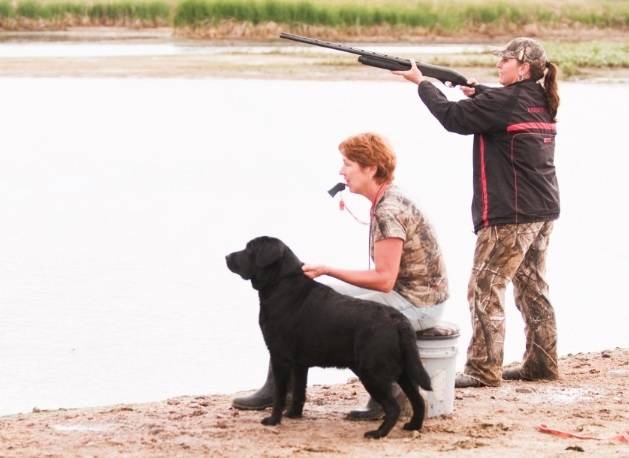
Senior vs Seasoned Hunting Tests
Although the basics are similar, there are a lot of differences between Senior and Seasoned tests.
What is similar
Both include double land and water marks, a land blind and a water blind, but they’re run differently.
Senior has two series: land double and blind, water double and blind, plus at least one diversion shot, a walk-up to start one of the tests, and an honor. Dogs that fail the first series are not called back to run the second series.
Seasoned has five tests: a walk-up, a double land mark, a land blind, a double water mark, and a water blind. There is also a diversion bird.
Pretty similar except Senior has a walk-up to start a double while Seasoned does the walk-up separately.
Collars
Dogs run without a collar in both organizations, but when the collar or slip lead is removed is different.
In Senior it’s removed before going to the line from the final holding blind. The dog is put back on a lead when the series is finished and the dog and handler are behind the judges. You may be asked to put your dog on a lead to honor if your dog has failed the test.
For Seasoned, the dog goes to the line on a lead and the lead is removed before starting the test. If the dog runs the marks and blind from a different line, the dog is put back on a lead when moving to the next line. The dog is also put on a lead when the series is finished.
Handling the shotgun
Handlers in both organizations must shoulder the shotgun. Senior tests have a non-operational gun and there is no shooting from the line. Seasoned tests require handlers to shoulder, aim and shoot a popper at each bird.
Blinds must be outside of the marks and delivering the bird to hand is required in both stakes.
Distance
In Senior, the test distance on land and water “should not normally exceed 100 yards.” While in Seasoned, the “maximum land test distance will not exceed one hundred (100) yards but may be shorter.” The wording is the same for water, but the maximum distance is 75 yards. The blinds “will not exceed sixty (60) yards…”
Diversions
In Senior, diversion shot(s) must be used and diversion bird(s) may be used. Switching or returning to an old fall in Senior is a failure. Seasoned requires a diversion bird that “can be thrown after the walk-up, blind, or last retrieve of a double mark.” Switching to the diversion bird is a mark-down, but not a failure in Seasoned.
Casting
Seasoned can be cast from the line two times per bird, but in Senior the dog can be sent more than once only in cases of confusion. There is no second chance if the dog doesn’t go when sent for a blind retrieve.
Popping
Popping isn’t penalized in Seasoned. It is a mark-down in Senior, earning a bigger penalty the more the dog pops.
Honoring
Senior dogs must honor a working dog at least once. There isn’t an honor in Seasoned.
Entry limits
Also, Seasoned limits the number of entries to 40 per flight. If you want to make sure you can enter check for when entries open and enter online as soon as possible after that. I’ve never seen an AKC club limit Senior entries. However if there are too many entries to finish the test in one day, you may have to come back. If the test starts on Sunday, that means coming back on Monday.
Titling
If a dog has a Junior title, four passes are required for the Senior title. Without a Junior title, five passes are required.
The Seasoned (“HR”) title requires forty (40) points for a title and can include points from Started (5 points per pass), Seasoned (10 points per pass), or Finished (15 points per pass). However, only 10 points from Started can be counted toward the Seasoned title. Basically, if you have a couple of Started passes you need three Seasoned passes. Otherwise, four Seasoned passes are needed for the HR title.
Watch an AKC Senior Hunting Test or an HRC Seasoned Hunting Test.

Master vs Finished Hunting Tests
In these tests, almost anything goes. There will be multiple marks and sometimes multiple blinds, diversion shots and/or birds, plus an honor and/or a walk-up. Dogs might run from a boat or from beside a layout blind. There may be a mixed bag of birds (for example, retrieving ducks and pheasants in the same series). Handlers of the working AND honor dogs may have to shoot at birds. There might be a “poison bird” (a bird the dog may not retrieve until he has done another task).
Luckily there are limits to what the judges can require.
What is similar
Dogs are taken off lead before leaving the holding blind. They are judged until the series is finished and the dog and handler are behind the judges. An exception is made when they’ve failed the test and have to honor on lead.
Although Junior or Senior entries aren’t usually limited, Master can be – and often is – limited. Clubs can choose to limit the number to 66, 100, 132, or 200 entries or can have unlimited entries.
HRC limits the number of Finished entries to 30 dogs per flight. Many clubs schedule a second or third set of judges to run more flights so more dogs can enter. Even with additional flights scheduled you should enter early as most tests fill up quickly.
Master test requirements:
- has three series – a land series with multiple marks, a water series with multiple marks and a land and water series with multiple marks
- at least two of the multiple-marking situations must have three falls before the dog is sent to retrieve
- a land blind and a water blind with at least one double blind
- dogs must honor at least once
- there must be a walk-up, diversion bird and/or shots at least once
- will be scheduled to run over a minimum of two consecutive days
Finished test requirements:
- has four tests – a land triple, a water triple, a land blind, and a water blind – may be required to retrieve in an established sequence
- at least one of the triples must include an honor
- the blinds may or may not be included with one of the triple retrieves
- there must be a diversion as the dog returns from any retrieve
- the test is completed in one day
Test distances
Master on land and water, shall not normally exceed 150 yards.
Finished land distance will not exceed 150 yards, but may be shorter. Water distance will not exceed 125 yards, but may be shorter. Blind retrieve distance will not exceed 100 yards.
Switching
In Master it shall be scored low, to the point of failing. But in Finished, switching to a diversion bird is a fail.
Controlled break
The Master dog fails, while the Finished dog may be failed for a controlled break or excessive, consistent creeping.
The use of the shotgun
A Master handler “shall always carry and shoulder an empty shotgun except when honoring the working dog or when running a blind.”
A Finished handler “must shoulder the shotgun, aim, track, and shoot at the top of the arc of the thrown bird.”
Titling
If a dog already has a Senior title, five passes are required for a Master title. Without a Senior title, six passes are required.
A Finished title (“HRCH”) requires 100 points and points can be earned in Started (5 points per pass), Seasoned (10 points per pass) and/or Finished (15 points per pass). However, at least 60 points must be earned in Finished with a maximum of 40 points from Seasoned. If 10 points were earned in Started, then a maximum of 30 points can come from Seasoned.
Watch an AKC Master Hunting Test or an HRC Finished Hunting Test.
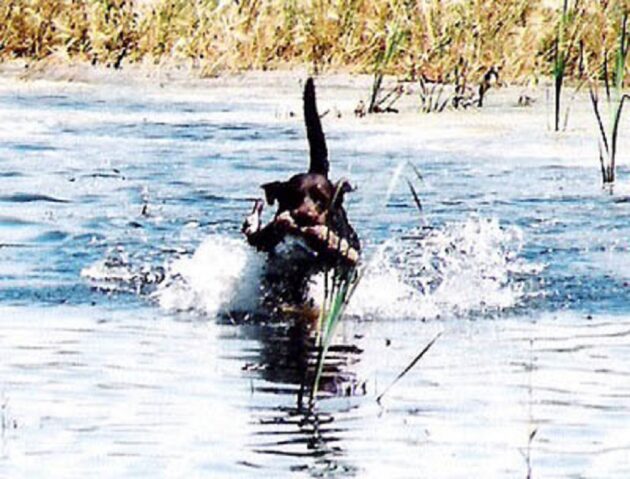
HRC Upland Hunting Tests
The Upland Hunter stake is designed for dogs trained to the Finished level. However dogs don’t need to have any titles before entering an Upland test.
There’s a simulated walk-up followed by a quartering test where the dog will locate and flush at least two birds. The handler must aim, track, and shoot a popper at birds his dog flushes, keeping gun safety in mind. Once the handler has fired a shot, the official guns may shoot the bird, if it can be done safely. The dog must retrieve any birds shot for him and must honor another dog.
Each passing score earns the dog 10 points with 40 points needed to earn an Upland Hunter (“UH”) title.
Watch an HRC Upland Hunting Test.

Master National vs International Grand
These events are very different from weekend hunting tests. Dogs must qualify to enter, their work is held to a higher standard, and the events are run over several days.
To qualify for the Master National, the dog must have passed six Master tests between August 1 of the year before the event and July 31 of the event year. There are exceptions for dogs running tests exclusively in Alaska or Canada. A dog that qualified at the previous year’s Master National needs four Master passes to enter. A dog that has the MNH title doesn’t have to requalify.
The Master National Hunter (“MNH”) title requires three passes at the Master National Hunting Test. This title is in addition to the MH title. Unlike other hunting test titles, the owner must request the title certificate and pay a fee.
There is also a Master Amateur Hunting Title (“MAH”) which is similar to the MNH. Dogs must pass the Master Amateur Invitational Hunting Test three times to title. The owner must request the title certificate and pay a fee.
Two Grand Hunts are held each year and are open to retrievers that have earned a Hunting Retriever Championship (“HRCH”) title. There are five series. Two series have multiple mark land tests with a blind retrieve and at least one honor and a diversion. The two multiple mark water tests must have a blind retrieve and at least one honor and a diversion. The fifth series consists of an upland quartering test.
Prompt and precise responses are expected from retrievers at this level. Distances may be longer than any weekend hunt tests. A quad or delayed quad and/or having the dog retrieve in a particular sequence can be used.
Watch a Master National or an International Grand.
Are you ready to run a hunting test?
Entering a test
Tests in both organizations can be entered online. Go to EntryExpress for AKC or HuntSecretary for HRC. (Note: be sure to check both platforms if you’re running AKC as some tests are showing up on HuntSecretary.)
Entries are limited in HRC and Finished usually fills up very quickly. Seasoned might fill up quickly as well. AKC tests can also be limited but generally only Master. Be sure to check for when entries open and close.
You can run your dog in HRC without a UKC registration, but you’ll pay more, and your dog must be registered within 60 days of earning points or you forfeit those points. Note: it often takes a month or more to get your registration from UKC.
Preparing to go
Start a list of what you should bring so you’re not scrambling at the last minute. For example, you might include:
- a collar,
- leash,
- whistle,
- duck call,
- crate,
- bug spray,
- sunscreen,
- sunglasses,
- rain gear,
- jacket,
- rubber boots and/or waders,
- water,
- shade,
- fan for hot weather,
- camera or cell phone with a camera (be sure to turn off the ringer),
- chairs,
- sunshade,
- coolers with drinks, snacks, and lunch.
Don’t forget “dark or customary hunting attire” for AKC tests. Or camouflage for HRC tests. If your family or friends are coming make sure they don’t wear anything white or neon colored.
Spray all your clothes with insect repellent about 3-4 days before the test. Seal them in plastic bags until the day of the test.
Re-read the pertinent portions of the rule book.
And don’t forget your dog! Don’t laugh – it’s happened.
Also, don’t bring: training aids like an e-collar, heeling stick, prong collar, choke chain, and especially a female dog in season.
Morning of the test
Be sure you know where and when you’re to meet and how to get there.
When you get there, check in with the hunt secretary at the headquarters and pick up a catalog. I mark my dog’s number on the catalog, or if I’m running more than one dog I’ll write their numbers on the back of my hand.
If you have a female, find out where to take her to be checked. Females in season, cannot run the test.
Air your dog on a leash and pick up any solids. Be sure to listen for the call to gather. The hunt chair will tell you where the stakes are located, restroom locations, parking, and rules for these grounds. No smoking and staying on roads are common rules.
When you get to your stake, make sure your dog is comfortable with water and shade. Then grab your whistle and duck call and find the marshal to check in. If you’re also running in another stake, let the marshal know. Sometimes the running order will be modified so handlers running in multiple stakes can finish one stake quickly. Be flexible if that happens.
Handlers meeting
When the judges are ready, they will call a handlers meeting where they will describe the test and what they expect. They will also go over gun safety. Even fake guns must be treated as loaded when you’re at a hunting test.
A test dog will run to demonstrate the test and judges will answer any questions. If you don’t understand something, ask. Be sure to check where the gallery can gather and pay attention to any other instructions given.
Airing your dog
Ask the marshal where you can air your dog so you don’t leave a pile where you’ll run the next series. Keep your dog on leash unless you are a very long way away from the line. Your dog will fail if he runs back and interferes with the running dog. Or worse if he starts a dogfight.
Don’t throw a bumper for your dog near the test as that can be interpreted as training on the grounds. And could potentially cause your dog to fail.
In the holding blind
Dogs can fail if they see another dog run a series before they run. Do your best to keep your dog inside the holding blind and not peeking around, over, or even under the blind. Also, do your best to keep your dog quiet so he doesn’t disturb the running dog.
If your dog takes a dump in the blind, let the marshal know so no one has to find it by accident.
Don’t leave the blind until the judges call you to the line. Often they will first ask for your number before calling you to the line.
If you still have any questions be sure to ask before running your dog.
At the line
Sit your dog facing the area of the fall take and take your time getting ready. Make sure your dog is looking in the right direction before signaling that you’re ready.
When there’s a dog honoring your dog, it’s courteous to ask if they’re ready before signaling to start the test.
In an AKC test, let the judges know you’re ready by nodding or waving a hand behind you. Do not turn around or your dog might get up. Wait to send your dog until the judge calls your number. In an HRC test, judges often have you blow a duck call to start the test. You can send your dog once the bird lands (or after the last bird in the case of multiple marks).
You don’t have to send your dog immediately. Be sure he is locked onto the bird’s location and ready to retrieve it first.
In a multiple-mark series, decide beforehand the order you want to pick up birds, but also pay attention to your dog. He may scoot a bit to get a better look at a bird. Or he might watch all the birds, but lock onto one once they’re all down. You can tell by watching his head or sometimes just his eyebrows. Ignore that at your peril, unless the judges have told you to pick up the birds in a particular order.
Also, remember to breathe!
Running the next series
Unless the judges have told you you’re out, wait for the marshal to do callbacks in AKC. If you didn’t pass the first series, you don’t get to run the next series.
However, in HRC, you can run both series. You don’t have to run the second series if you think it might compound any errors your dog made. Just be sure to tell the marshal so they don’t spend time looking for you.
If you’re still in the running, there will be another shorter handlers meeting and a test dog. Again ask any questions you have.
Although the running order might change, your dog’s number remains the same.
Getting your ribbon
The marshal will tell you when and where ribbons will be given out. Most HRC clubs have a Saturday night social and give out ribbons there. However on Sunday ribbons are often given out shortly after finishing the stake. Usually, they do it at the test headquarters, but check to be sure.
Most AKC clubs will meet at the headquarters after judges have reviewed their judging sheets and discussed passes and fails.
You should go even if you’re sure your dog failed because you can ask the judges why your dog didn’t pass. Just remember to be polite!
The drive home
Pass or fail, remember the important point is spending time with your dog. Make it a tradition to stop for a hamburger or other treat as a reward for your dog.
If you got a ribbon, display it proudly on your dashboard. Take a picture and post it on social media. If it’s your first pass or maybe the first pass at an upper level, shout it from the rooftops!
And even if you and/or your dog totally bombed, someday you will look back on this day and smile. Believe me, I know.
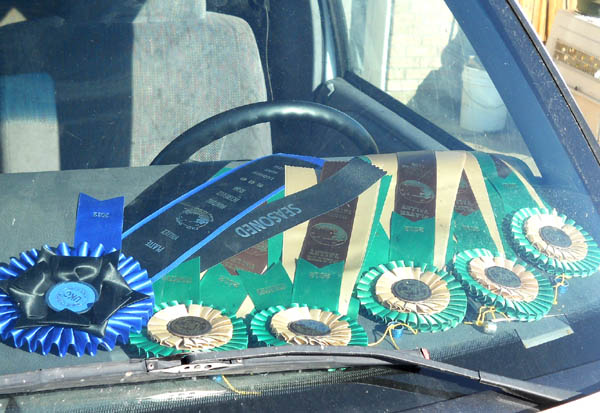
Ready to do it again?
I hope so!
Take stock of how you and your dog did and what weaknesses you should work on. Make a plan for how you can do better next time.
Other organizations
There are other retriever competitive associations:
This post was originally published on January 24, 2022. Edited and updated with new content on July 12, 2024.
Header image by Linda Alexander.
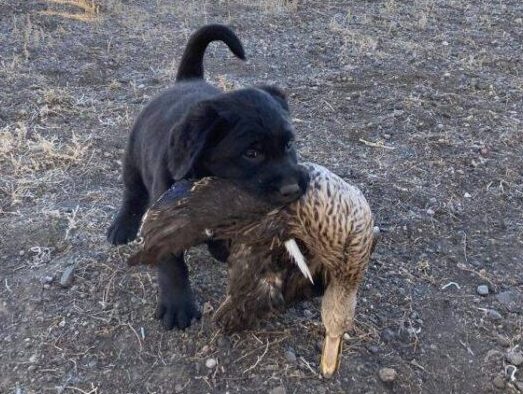

Browse this list of helpful links for Labrador Retrievers – clubs, competition, health issues, and more.
To request a link to a Lab club website or other helpful link or to update an existing link, please contact us.
National & International Dog Clubs
American Kennel Club (AKC)
Canadian Kennel Club (CKC)
Federation Cynologique Internationale (FCI)
The Labrador Retriever Club Inc
Master Amateur Retriever Club (MARC)
Master National Retriever Club (MNRC)
North American Hunting Retriever Association
Dog show info
List of AKC Licensed Dog Show Superintendents
Hunt test and Field trial entries
Health
American College of Veterinary Ophthalmologists (ACVO)
American Veterinary Medical Association
ASPCA Animal Poison Control Center, 24-Hour Emergency Number
888-426-4435
Animal Health Diagnostic Center
Genetic & Health Testing
US Labrador clubs
Dallas-Fort Worth Labrador Retriever Club
Greater Atlanta Labrador Retriever Club
Heart of Texas Labrador Retriever Club
Huron River Labrador Retriever Club
Labrador Retriever Club of Greater Denver
Labrador Retriever Club of the Pioneer Valley
Labrador Retriever Club of Southern California
Labrador Retriever Club of the Potomac
Mid-Jersey Labrador Retriever Club
Puget Sound Labrador Retriever Association
San Diego Labrador Retriever Club
Spirit of St. Louis Labrador Retriever Club
Winnebago Labrador Retriever Club
Lab links
Coat Color Inheritance in the Labrador Retriever
Other
Dog Lovers Bookshop (hard to find used, out of print and rare books)
Therapy Dogs International, Inc. (TDI)
Header image AI generated via Canva
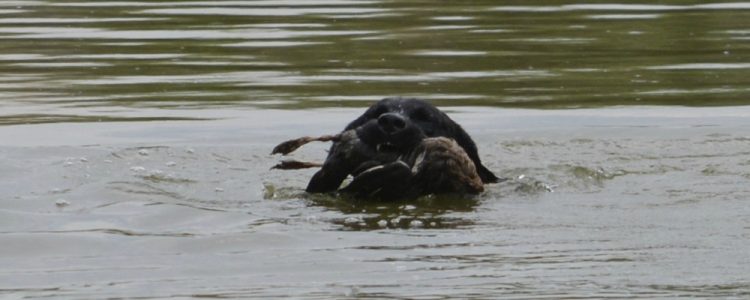
The Working Certificate – or just WC – is a fun test for Labs and their owners. One short retrieve on land and two back-to-back retrieves in water is all that’s needed.
Some Labs take to it (dare I say?) like a duck to water. Other Labs take a bit of coaxing. That’s where being a member of a local Lab club comes in handy.
There’s also a Working Certificate Excellent, or WCX test, offered by some clubs. However the LRC only offers the WC test.
A bit of history
When The Labrador Retriever Club, Inc. was founded in 1931, The Kennel Club in England required sporting dogs prove working ability. Without it they could not earn a conformation title.
Using that as a guideline, the LRC created the WC test. It isn’t a requirement under American Kennel Club rules. However the LRC requires members’ dogs to have a WC before they can be called a show champion.
Requirements of the Working Certificate test
The WC requires your dog to retrieve a single shot bird at 50 yards. Generally pheasants or ducks are used with ducks being the most common. Sometimes pigeons are used.
Usually the birds are already dead and the gunshot is just a simulation. Live birds can be used, however that requires a good gunner and scrupulous safety measures.
This isn’t a marking test like hunt tests and field trials. The core requirement is for your dog to retrieve a bird to you (or at least close to you). The judge will define how close your dog must bring the bird – generally within about five feet of you.
The retrieve doesn’t have to be to hand or fast or even pretty.
Your dog doesn’t have to be steady. You can restrain him by holding his collar or with a leash wrapped through the collar or wrapping your arms around him. For safety, the collar should not have dangling tags. They can be removed or taped securely to the collar.
Handling or directing your dog to the bird with hand signals or other commands is not permitted.
Your dog must also complete two back-to-back water retrieves to show a willingness to re-enter the water.
Download a copy of the WC brochure.
Differences between a WC and a Junior test
This is totally different from an AKC Junior test. It’s not a marking test. It’s only about retrieving. The questions is: Will your dog pick up a duck and bring it back to you?
If he drops the bird ten times, but makes progress back to you and gets the bird into your area, it’s good.
It’s a test of natural ability, not a test of how you trained your dog.
One dog’s experience at the WC
The Labrador Retriever Club of Greater Denver hosted a Working Certificate test near Franktown, Colorado. The property was nicely set up for retriever training. Lots of people and dogs turned out for fresh air and some rather ‘moist’ skies!
Wynk started off with one mark on land – near the top of a little hill – no problem. But there was something new, something she’d never seen before. A blind (camo fabric) out in the field, hiding people.
‘What’s that?,’ she asked. So she had to go take a peek and say hello to the bird boys. Then remembered she had to get her bird back to mom! Scooped it up as she ran back and delivered to hand. Land portion completed!
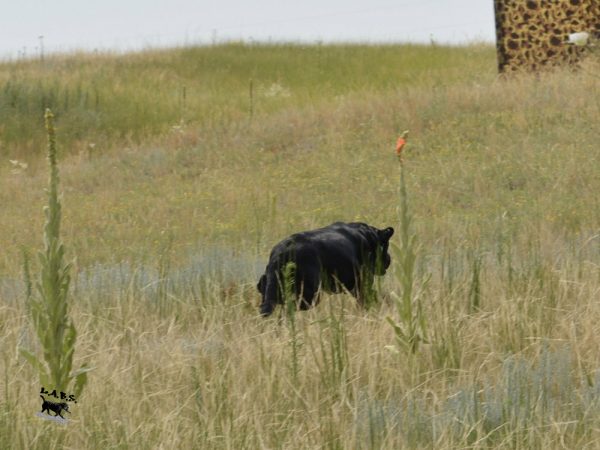
After a bit, we worked the water portion – back to back retrieves in a pond enclosed by tall reeds and other vegetation.
Another new experience for Wynk.
Out and back, delivered to hand for each mark, with her signature squeal as she left the line. Quite proud of my little Lab!
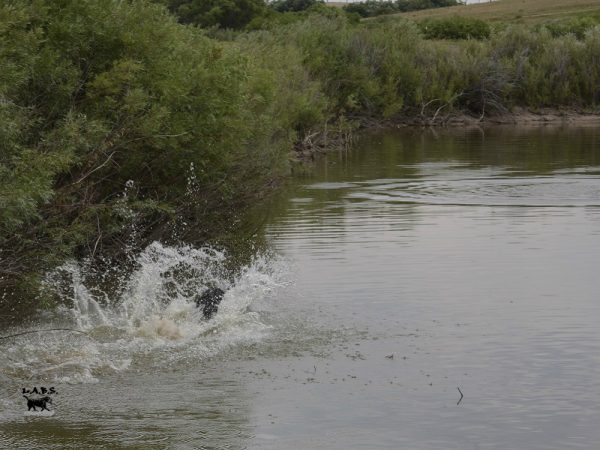
Photos by Linda Alexander.
Preparing for the Working Certificate test
Let’s dive in to the what and how.
Lab clubs often have training days in preparation for an upcoming WC test. If you’re not a member of one you can check for local Lab clubs.
If there isn’t a Lab club nearby, try contacting other retriever clubs. Their training could be different than training for an LRC WC, but they may be able to accommodate your needs. Especially if you volunteer to help set up, throw birds, run a winger station, or tear down.
As a last resort, you can practice on your own. You will need at least one duck and a helper to throw the bird. To start, put your dog on leash and let him see and smell the bird. Waggle it around to get him interested, then toss it about five feet as you run out with him. Praise him for running to it. Praise for picking it up. Let him hold it for a bit. Then repeat, but no more than two or three times.
If it didn’t go too well, try being more excited. Waggle the bird more. Pretend you’re playing keep-away. Have your dog, on leash, watch another dog retrieve the bird. Praise for every tiny improvement.
To use the bird for multiple sessions, wrap it in newspaper and put it in a plastic bag. It will last longer if you freeze it in between sessions. You may also want to warn your family about the foreign object in the freezer.
Land retrieve
Your dog’s manners getting from the holding blind to the line don’t count. Just keep a firm grip on the leash.
It’s a fairly short retrieve of about 50 yards.
The gunner often wears white to be very visible.
Get your dog to sit or stand next to you and facing the gunner. Take your time. When you’re ready, restrain your dog in any way you want. Then signal or say you’re ready.
After that the judge will signal for the gunner to start. Wait for the judge to release you by saying your number or something like “dog.” This gives the judge time to call a “no bird” if something went wrong. You don’t have to release your dog immediately.
The bird will be thrown into light cover and should be relatively easy for your dog to find. There could be a small hunt or, in some cases, a big hunt.
You can encourage your dog. Find it, fetch it up, where is it? are all good. You can use a whistle. You can do almost anything you want to get your dog to pick up the bird and bring it back. Ask the judge if you’re not sure.
The main objective is for your dog to pick up the bird and bring it back to you. The judge may require him to cross a specific line or he might have an area marked out.
Your dog can sit at heel and present the bird. Or drop it near you. Or, if you’re quick and agile enough, you can snag the bird as your dog rockets by you.
Any way you get it, hand the bird to the judge or a “bird boy” and you’re done. For now.
Water retrieves
These test whether your dog will re-enter the water after retrieving the first bird. Again it’s not a marking test. The core requirement is for him to go back in the water to retrieve a second bird.
Each bird is thrown and retrieved separately. It’s not like a double marked test.
Your dog doesn’t have to deliver to hand, but should bring the bird up onto dry land. He can be coaxed if needed to get him into the receiving area. He can also run the bank, but must bring the bird to you.
There’s no rush to do the second retrieve. Get your dog under control and looking out where the next bird is going to be. Signal for the bird when you’re ready.
Once your dog has delivered the second bird to the area of the handler, you’re done. Take a breath!
After all the dogs have run, and your dog passed, you will get a form signed by the judge(s). Send that form to the LRC with the fee (currently $25) to get your working certificate. Some clubs give out their own certificate and/or a rosette to passing dogs to commemorate their success.
Other ways to earn a WC
If there isn’t a Lab club near you that hosts WC tests, here are some alternatives:
- Complete both a land and water series in an AKC licensed field trial or receive a placement or judge’s award of merit in an AKC licensed field trial
- Complete an AKC Junior hunter title
- Earn one leg in an AKC Senior or Master test
And there you have it!
The WC test is a great way to get a feel for running a dog in field events. Young people are encouraged to give it a try. Many experienced handlers had their first taste of field events at a WC test.
It’s also a good way for reputable breeders to show the working ability of their dogs. And it gives Lab owners appreciation for their dog’s abilities without a big commitment to field training.
I hope you will get involved in field work with your Lab. Happy training!
—
This article was originally published on July 24, 2018. Updated on May 10, 2024.
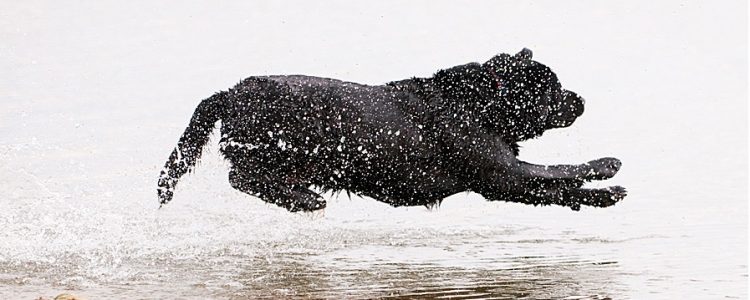
The last local AKC retriever hunting test of the season is in the books.
Beautiful property with fabulous water, good weather (yes, a bit hot) and lots of great dogs and their handlers.
There was even a chocolate Lab I’ve got my eye on!
My co-judge, Jeff Baldwin, drove all the way from Utah to bake in the high plains sun. Wyoming kindly sent us some of their wind every afternoon.
We designed the Senior hunting test on Friday. Jeff judged Junior on Saturday while I worked at Master. On Sunday we judged Senior together.
It was a long weekend.
What did we set up and why?
The requirements for an AKC Senior hunt test are:
- a double retrieve on land
- a double retrieve on water
- a land blind
- a water blind
- an honor
Then we had to throw in a live flyer, a walk-up, a diversion shot and multiple decoys. Plus adding some other trappings to simulate a real bird hunt. (See the Glossary below.)
We chose to start off with the land series in the morning. Having the water series afterward gave the dogs a chance to cool off in the afternoon heat.
The first two photos were taken from the “line” – the spot where handlers bring their dogs to start the test.
To begin, we called for a “handler’s meeting” to introduce ourselves and describe the test. Often there are several questions.
Next we ran a “test dog” (a dog who was not in contention). He ran the test to make sure everything worked as planned and to show the handlers the test set up.
Of course, the dogs in contention didn’t get to watch!
After completing the two marks successfully, the test dog and handler moved to the “honor box” which is a spot nearby where the dog can watch the next dog work.
This is often a challenge for dogs at this level.
Having just completed two retrieves the honor dog is often excited, but must be “steady” (remain quietly in place) off leash. He must watch the next dog retrieve at least the first mark.
Starting the Senior Hunting Test
Next the handlers lined up in “holding blinds” (fabric set up to block the dog’s view of the test). AKC suggests dogs run in catalog order. However some handlers run dogs in other stakes and may need to run out of order.
When we were ready, we asked the handler in the final holding blind for the dog’s number. Leashes come off before leaving that holding blind to run the test.
To simulate a real hunt, handlers had to shoulder and point a shotgun as each bird was thrown. The handler’s gun is usually disabled for safety, but must be treated as a loaded gun. That applies even if the “gun” is only a wooden cutout.
When the handler signaled they were ready, we had bird tech #1 throw the first bird. This was a duck from a winger hidden behind a clump of trees near the left side of the field.

The bird went from right to left and landed in some rather sparse cover, about 70 yards away. Just before throwing the bird, the bird tech blew a duck call and shot a blank to get the dog’s attention. There were also multiple goose decoys the dogs had to run through to get to the bird.
Many dogs wanted to retrieve right away, but they had to be steady and wait for the second bird to be thrown – a “double retrieve.” This bird was a “flyer” (a live bird that was thrown and then shot in the air) which is very exciting for the dogs. All the other birds were already dead before being thrown.
The second bird
Bird #2 came out of a winger hidden behind the berm that ran parallel to and behind the line of trees. Flyers rarely land in exactly the same place so the distance to the bird varied, but averaged about 60 yards.

Because of the excitement caused by a live flyer, several dogs “broke” (ran to retrieve it before the handler’s command). Dogs that retrieved the bird without being released were disqualified. However if the handler was able to stop the dog quickly (within about 15 feet) they were allowed to continue. They were penalized for a “controlled break.”
Some dogs didn’t break, but moved a little bit towards the birds. This is called a “creep” and is penalized, but less than for a controlled break. Dogs moving beyond the length of the gun barrel had to return to heel before they could retrieve.
After both birds were down, we had the handler send their dog. They could pick up the birds in any order, but usually chose to get the last bird down first. This is especially so when that bird is a flyer!
After delivering one of the birds “to hand” they were sent to retrieve the other bird. When the working dog was sent on the first retrieve, we dismissed the honor dog.
If the working dog did a passable job on the double retrieve, they next had a “blind retrieve.”
Problems
Sometimes dogs forgot where a bird landed and had a big hunt or ran towards where they already found a bird.
Returning to an old fall and switching are both disqualifications. They are similar faults. “Returning to an old fall” is going back to where they already retrieved a bird. “Switching” is abandoning a hunt for one bird to go to a different bird.
When a dog hunted too far away from the bird or started toward the other bird, handlers blew their whistle. At that point the dog was handled to the bird using the same technique as a “blind retrieve.” This means directing the dog to a bird he didn’t see fall.
The blind retrieve
We “planted the blind” (placed a bird in the field when the dog wasn’t watching) near a bush 50 yards away.
To get to the blind, the dog had to pass some larger bushes and diagonally cross a dirt track. The location was to the left of bird #1 and slightly out of the left side of the first photo.
For a passing score, the handlers had to “challenge the blind.” This means keeping their dogs close to a direct line to the blind. Dogs should not run all around in hopes that he would eventually find it on his own.
Dogs were penalized if they didn’t:
- stop on the whistle
- take the correct cast
- maintain the new direction for at least a few yards.
Senior dogs are at an intermediate level of training and still learning so each penalty was only a minor deduction.
Thirty-one dogs did a double retrieve, blind retrieve and an honor. Twenty-nine competed plus a test dog (honored the first dog) and a bye dog (retrieved while the last dog honored).
Dogs that had a passing score on land were “called back” to run the water series.
The water series
We moved a 1/4 mile south to a spit of land. There was a water channel on the left side and open water on the right.
This series included a double retrieve and a blind retrieve with a walk-up and a diversion shot. No honor, no live birds.
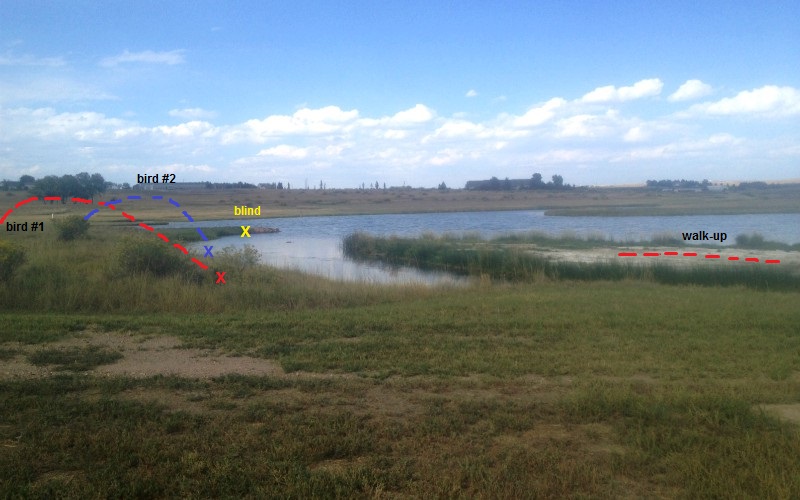
To start, the handler walked down the spit with their dog at heel. When they got to a certain point, there was a gun shot and a bird was hand thrown. It landed in grass about 8-10 inches tall and about 4-6 feet from the water’s edge.
The second bird came out slightly left to right, with another gun shot. It landed with a splash about half way down the channel. Both bird techs were hidden behind tall bushes.
The dogs could retrieve the birds in any order. When they were returning with bird #1, there was a diversion shot to set up the blind.
Most dogs did fairly well to great on the water double retrieve. There were a few that needed to be handled to one of the birds. A few dogs needed to be handled to the memory bird on land and one of the birds on water.
The blind was across to another spit of land and was placed just out of the water.
There was some suction to old falls and to a bit of land poking out of the water. Otherwise this was a straight forward blind. All the dogs who attempted it did fine.

Summing up…
Our goal was to make both series as hunt-like as possible while staying within AKC’s rules for a Senior hunting test.
We also wanted the handlers and dogs to enjoy it and to make sure everyone was safe.
Some dogs did very well overall. Other dogs did better on one series or the other. And some dogs had enough trouble that we couldn’t give them a ribbon this time.
I’m grateful to the Mile High Golden Retriever Club for asking me to judge. To the owners and handlers who entered their dogs. To all the helpers for handling the myriad of jobs. And to my co-judge who made it so easy, it felt like we’ve been working together for years.
By the way, all of my dogs got to experience that great water.
The adult dogs loved it. The younger ones quickly learned that the end of grass doesn’t always mean there’s a gentle slope into shallow water. However they did get to practice new swimming skills.
And the drive home was rather quiet – except for some snoring coming from the back.
Update: I’m sad to say Jeff has left the bonds of Earth. I hope he’s been reunited with family and friends and, of course, his favorite dogs. We miss him greatly.
Glossary for a Senior hunt test
BLIND RETRIEVE – The dog is sent to retrieve a bird that it did not see fall. The dog is expected to take hand, voice and whistle signals to direct it to the bird.
DIVERSION – Either a shot or a fall designed to divert the dog’s attention from the task at hand.
DOUBLE – Two birds to retrieve.
HONOR – Dog to sit quietly off-leash on or near the line while another dog retrieves.
MARK – A retrieve that the dog has seen fall.
MEMORY BIRD – First bird the dog sees thrown/shot on a multiple mark. Usually the last retrieved.
STEADY – Dog does not leave assigned spot until instructed by the handler to retrieve.
WALK-UP – Bird is thrown while handler and dog are walking with the dog at heel, much like jump shooting.
By: Rich Carpenter
You can see the entire glossary on the Platte Valley HRC’s website.
Originally published September 22, 2018.
You might also like –
We had a great weekend – despite the heat and wind near Boone, CO at an HRC hunt test. Arwen passed a tough Finished test, Tory passed his third Seasoned test, and Jazzy got to run two Started tests and passed both!
Finished test
The Finished test started with a wide-open triple retrieve and a diversion as the dog returned with the last bird. Although it was called a dove hunt, we rarely use any birds except ducks because they hold up better. I’ve seen pigeons or chukar used on rare occasions, but only for the land retrieves.
After the triple we did a blind retrieve with lots of suction to the nearby dike and to the old falls.
Arwen did fabulously in this series! And I, crack shot that I am, knocked down every bird I shot at.*
Finished, Part two
When all the dogs completed the “dove hunt” land series we moved to the water series with ducks. This series was a mind-bender trying to remember which bird is shot at by which handler and which dog got to retrieve.
It started off with a buddy on the honor bucket as Arwen and I walked down the muddy path. On the way, a duck came sailing in from the left. Both handlers shot at it, but remembering not to shoot in the direction of the other handler! The honor dog picked up that bird while the working dog (Arwen) had to watch.
Once we got settled on a bucket, a duck came in over our right shoulder. Followed quickly by another duck that came in from the left. Both handlers shot at the birds. Arwen picked up the left bird after a long swim, then rooted the right bird out of the reeds.
Somehow with all that “shooting” we put down another bird way off to the left. This set up a blind retrieve. The line to the bird was just off the beach with suction to the shore and to the old fall. With a couple whistles to keep a tight line, Arwen picked up that bird.
Time for a new “hunting buddy.” As he came down the path with his dog, we moved to the honor bucket, but this dog was amped! When he came into sight Arwen must have figured she’d need a head start to beat him to HER birds. She took a few steps toward the water during the double, but luckily decided not to go any further. Good dog!
Thanks to judges Erik Brekke and Tim Boies for a fun test!
Seasoned test
Seasoned is a pretty big step up from Started. There are five tests: a walk-up, double land mark, land blind, double water mark, and a water blind. There’s also a diversion bird.
Tory did well on the water blind, but needed a handle on the water memory bird (as did most dogs). The walk-up was along the tree line, followed by a double mark with a diversion bird. Then a walk back to the first side of the trees for the land blind. Tory did great on all of it.
The hardest part was the long wait to get through the five tests for all of the dogs.
Thanks to judges Faron Eddy and Bob Moreschini!
Started test
The Started test began on the very muddy shore of a large pond. My friend was one of the first handlers to run the test and it was her first test. She did great, except for not letting go of her dog’s collar in time.
Boots stuck in the mud and her dog leaping forward led to a full body splat in the mud. After cleaning up, she went to try again only to be told by a judge that her dog failed. As a judge myself, I disagree with that judge’s decision. Started often has beginning level dogs and inexperienced handlers. For the sport to survive, we need to encourage new people. I applaud my friend’s courage to try again and to continue running her dog to complete his Started title.
My dog, Jazzy, did great on the water marks, although I teetered a bit in the mud. She also did great on the land marks, but was a little sticky on one bird. However I wasn’t too concerned as it was the first time she’d retrieved a pigeon. Before this test she had only retrieved bumpers and ducks.
*Note: We don’t use live ammunition in HRC hunt tests. There is an exception for Upland tests which uses live birds. Even in that case only designated shooters have live ammo. Handlers have blanks, but must treat all guns as if they’re loaded.
Conclusion
If you haven’t been to an HRC hunt test and would like to learn more, check out the Hunting Retriever Club’s website. There is also information about local clubs. Check if there’s a club near you and see if you can join them on a training day.
Another option is to search for hunt test videos on YouTube. There are quite a few to choose from, plus more videos about AKC hunt tests.
Originally published May 25, 2010.
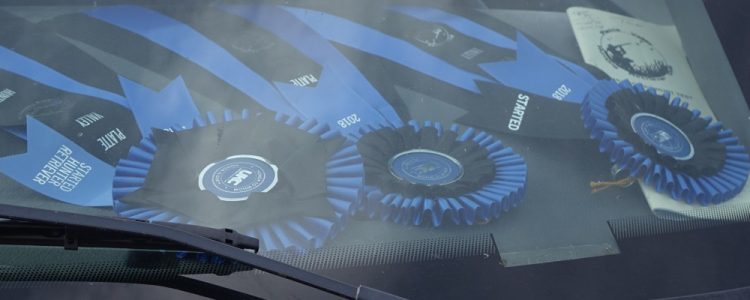
Completing Tisket’s hunt test title
We ran in the hunt test at Indian Meadows in Snyder, Colorado. Tisket only needed two passes to complete her Started hunt test title (SHR), so she was entered both days.
The first land mark on Saturday was in fairly heavy cover and a bit shorter than what we’d practiced. Many dogs, including Tisket, overran the mark and had to work their way back, while honoring their noses. Tisket ran back and forth where she thought the bird had dropped, to try to pick up the scent. You could tell when she caught the scent because her nose looked like it had been snagged by a fishhook.
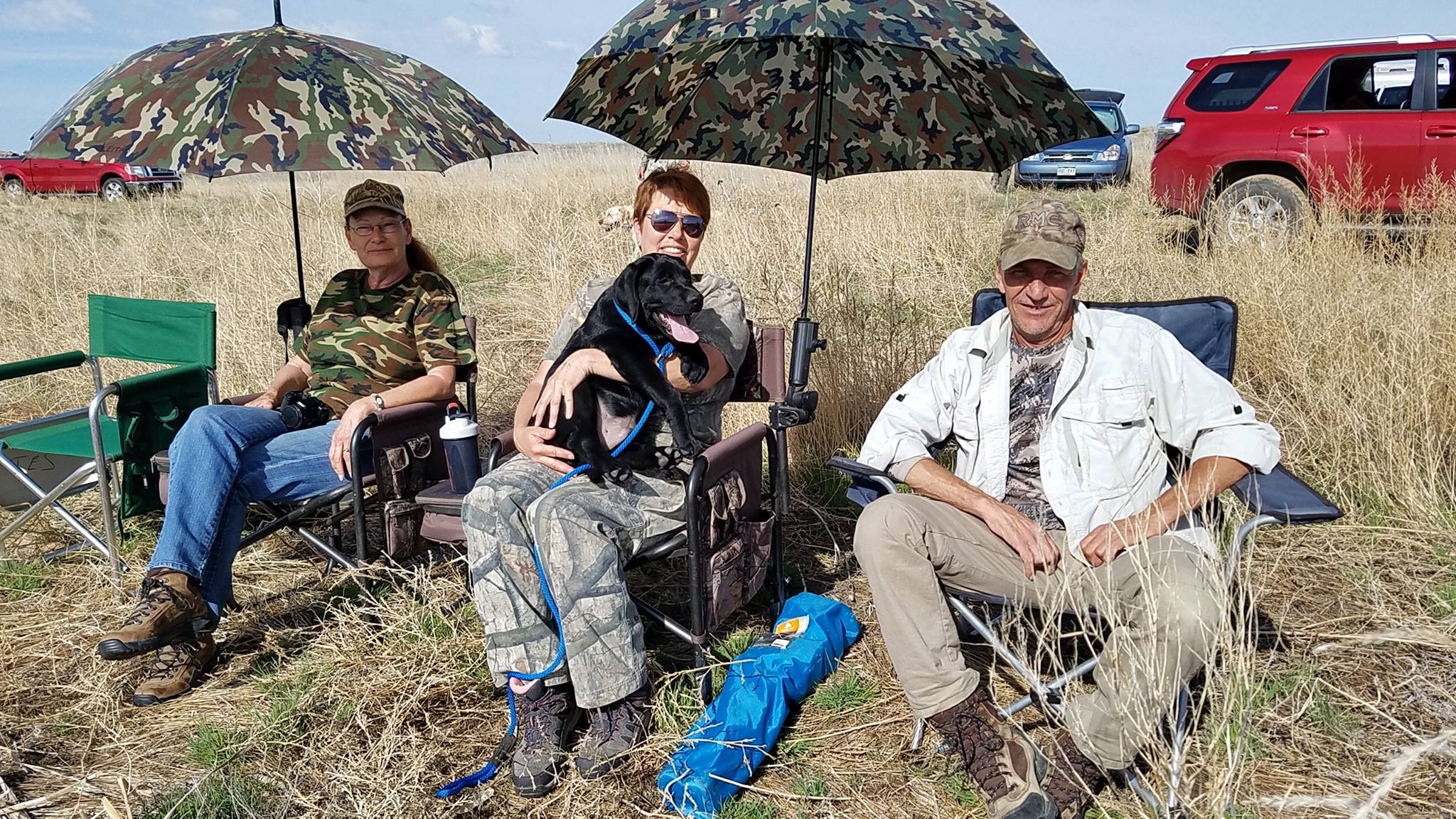
She ran straight to the second mark – “stepped on it” – and brought the bird back to me. The land marks were done, next up were the water marks!
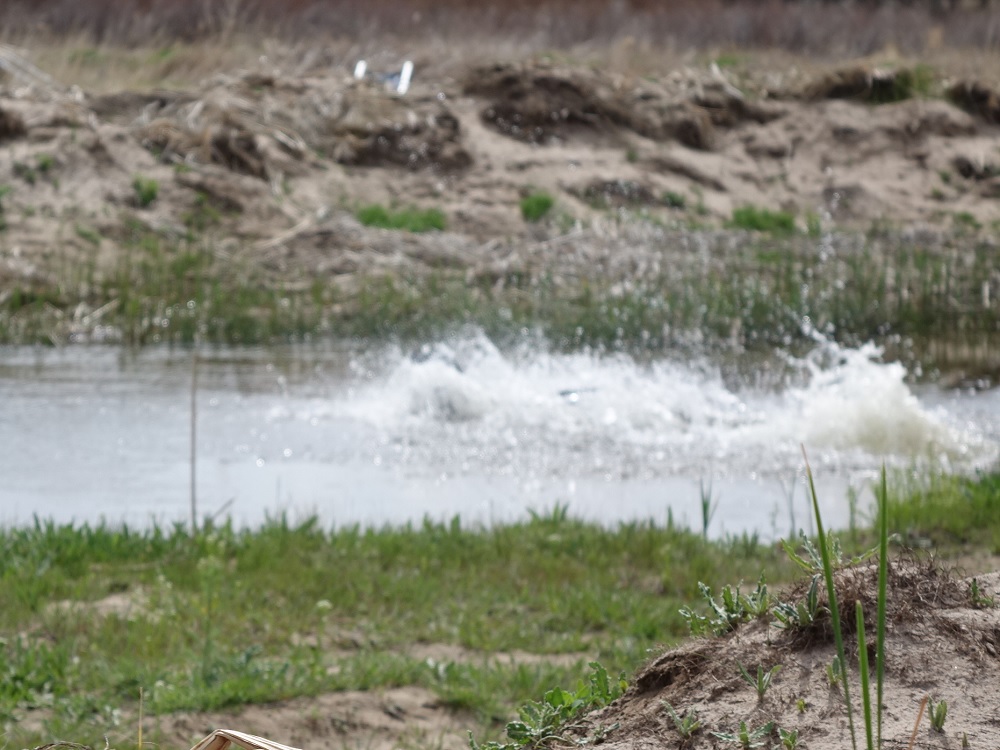
The water marks were set up at the end of a spit of land. The first mark was across a channel into a marshy area to give a slight splash when the birds landed. The second mark was to the left in open water on a good-sized pond.
Tisket did great on the first mark, except she had to check the decoys on the way back. She never dropped her bird, but had to bump each decoy with her nose to make sure it wasn’t real.
The open water swim was out and back, despite the slight chop due to the wind.
Another pass for Tisket!
Wynk’s first hunt test
On Sunday we started with the water marks and Tisket’s daughter, Wynk, got to run for the first time.
Both marks were across a channel – wider than yesterday’s location – and onto a sandy bank with sparse grass.
Tisket was out and back quickly on both birds. Very nice retrieves.
Wynk came out raring to go! There wasn’t room for a running start, but she leaped into the water with a big entry and picked up each bird in turn. No time wasted hunting around – she knew exactly where her birds were.
On to the land marks for both girls!
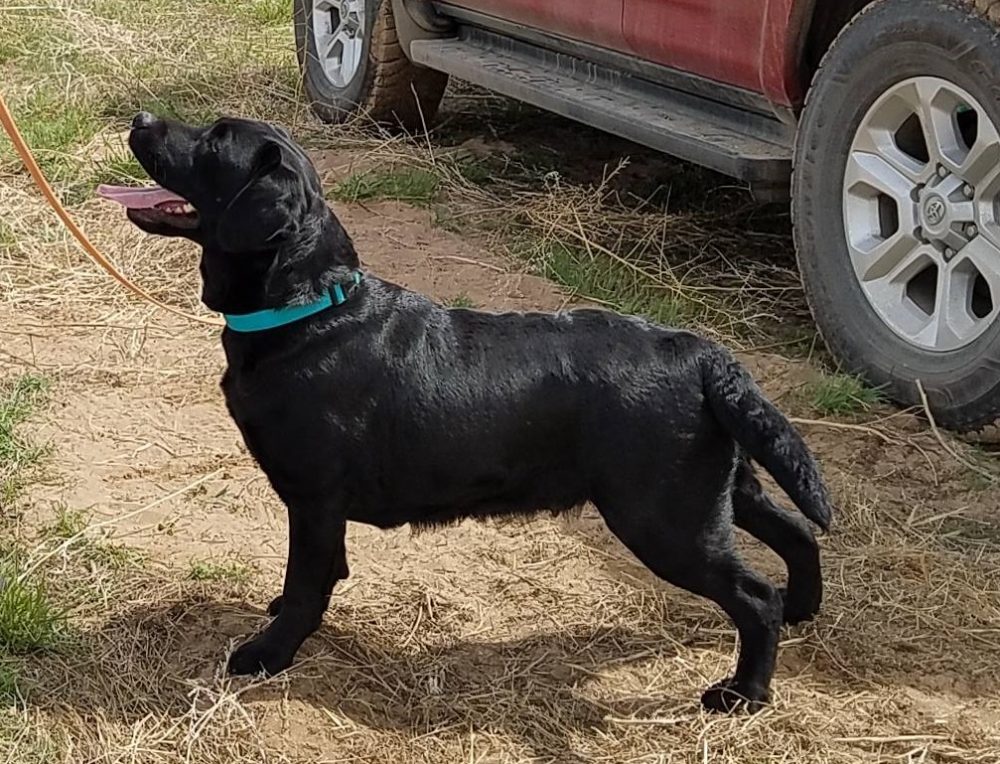
It was hot and starting to get muggy with a thunderstorm brewing to the west. Didn’t bother either girl in the least.
Tisket ran first again. Out, scoop up the bird and back in no time. The second bird landed in a little swale and she overran it by a yard or two. But she turned quickly, scooped it up and brought it back to me. No question she picked up another pass and that was enough for her title!
Wynk came out raring to go again. Good, because I was wilting with the heat and humidity. Although she’s not very tall, she motored her way to each mark and surprised a few people with her speed. Out and back quickly on the first mark. Slide and turn as she tried to pick up the second bird without stopping. No question; she likes this game!
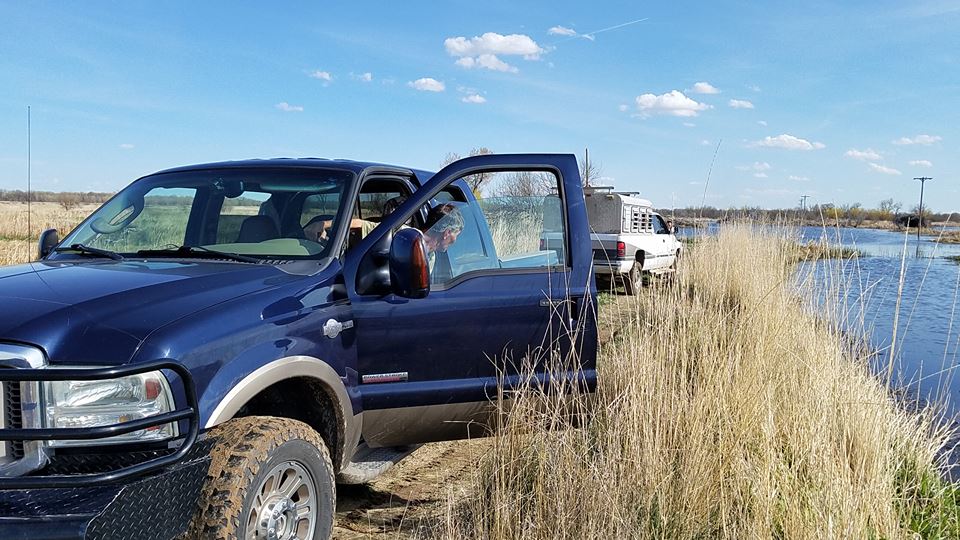
Overall, great weekend.Platte Valley HRC’s club members, helpers, and judges did a good job.
Tisket finished her title, Wynk got her first pass and my truck didn’t stay stuck for long!
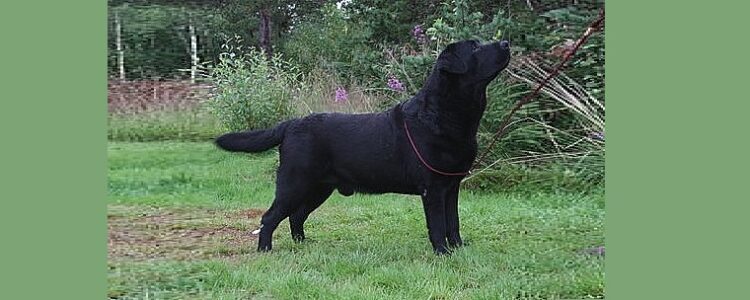
Dickendall Peacekeeper was nicknamed “Chuck” after Chuck Norris, the actor and martial arts expert. Like Chuck (the person), Chuck (the Lab) was sweet and mild-mannered until it was time to go to work – then watch out!
He finished his Junior Hunter title with style and was working on his Senior Hunter title when his handler had a health issue and wasn’t able to finish his title.
Instead, Chuck went globe trotting and spent over a year in Finland where he was popular with the ladies. He is now retired.
Chuck was bred and owned by Dickendall Labs.
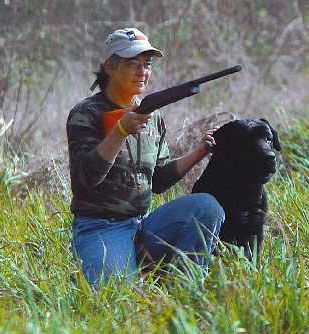
Below is a photo of Chuck’s father, Morgan. He was imported from Europe where he often won in dog shows.
According to Morgan’s owner, “He has 3 CC’s and 2 CACIB’s from Holland, 2 CC’s and 1 CACIB from Finland, 1 CC and 1 CACIB from Sweden and 1 CC from Italy, and several BOBs. He gained the NLV CW’99 title, when winning the dutch Bennekom Club Show out of 800 labradors. He is also Nordic Winner ’99.”
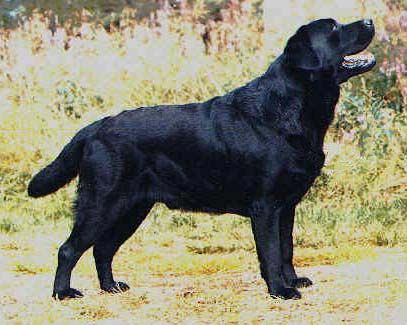
Chuck’s clearances and pedigree:
Hips OFA LR-145035 Good
Elbows LR-EL23955
Eyes CERF: LR-40971
| Dutch CH Trendmakers Tycoon “Morgan” |
Swedish Danish Nordic CH Trendmakers Mugwump | Beechcroft’s Royal Standard |
| Guideline’s Manuscript | ||
| Trendmakers Traffic Jam | Smart Fellow’s Order From New York | |
| Blondella Balanced Shades | ||
| Dickendall Davaron Peaceful | CH Dickendall Arnold | CH Dickendall Ruffy SH |
| Dickendall’s A-Ha | ||
| Pucketts Ping Pong | Follytower Man O’War | |
| Dickendall H Of Criner Hills |
His legacy
We had one of Chuck’s very talented daughters, SHR Justamere Jazz Singer CD JH RE CGC WC CC, or Jazzy for short. Jazzy loved retrieving and snuggling on the couch. She gave us another generation of talented Labradors.
Jazzy’s brother, Jack, was also a very accomplished Labrador. His full name with titles is SHR Justamere Jack O’ The Green RAE JH CC.
Two of Chuck’s sons finished their championships – CH Buckstone Surviv’n On Ayr “Martin” and Ukn CH Mallorn’s Madmax.
Other dogs sired by Chuck include:
Banbury’s Sweetest Taboo
Brooks Major Decision
Brooks Here To Start The Party At Countryhaven
Hightide Snowworry Just Chilln
Whispering Pine’s Bewitched

These are mostly American titles (AKC and UKC/HRC), but there are also some we see from Canada and England.
In the pedigrees I share I try to differentiate between titles earned in the US versus other countries.
For example, CH = AKC show champion, U-CH = UKC show champion, Can CH = Canadian show champion, Mex CH = Mexican show champion, Eng CH = English full show champion, and English Sh CH = English show champion.
Also included are some that are not technically titles because they’re not bestowed by the country’s governing body.
For example, WC and CC are certificates given by The Labrador Retriever Club rather than by AKC.
There are many organizations awarding titles, but these are the main titles we see for the retriever breeds.
FIELD TITLES |
|
|---|---|
| DC or DUAL CH | A Show Champion AND Field Champion – Note: We haven’t had one of these in Labradors since the early 1980s |
| FC | Field Champion |
| AFC | Amateur Field Champion |
| “C” in front of FC or AFC | Canadian Field Champion – sometimes seen as FTCH |
| “N” in front of FC, AFC, CFC OR CAFC | National Field Champion titles |
| Eng FTW | English Field Trial Winner (part of the Eng FTCH, but not actually a title) |
| QAA | Qualified All-Age – means the dog has won enough in the Qualifying stake to compete in the Open or Amateur stakes at field trials, not actually a title (sometimes seen as *** following the name) |
| QA2 | Qualified All-Age 2, recent AKC title for dogs that have twice met the requirements to compete in the Open or Amateur stakes at field trials |
| JH | Junior Hunter |
| SH | Senior Hunter |
| MH | Master Hunter |
| MNH | Master National Hunter – listed as MNH4 or MNH5, etc when the dog has passed the Master National more than 3 times |
| SHR | Started Hunting Retriever (HRC/UKC title) |
| HR | Hunting Retriever (HRC/UKC title) |
| HRCH | Hunting Retriever Champion (HRC/UKC title) |
| GRHRCH | Grand Hunting Retriever Champion (HRC/UKC title) |
| UH | Upland Hunter (HRC/UKC title) |
| CPR | Certified Pointing Retriever (APLA title) |
| APR | Advanced Pointing Retriever (APLA title) |
| MPR | Master Pointing Retriever (APLA title) |
| GMPR | Grand Master Pointing Retriever (APLA title) |
| WC | Working Certificate (LRC certificate) |
| WCX | Working Certificate Excellent (sometimes awarded by local breed clubs) |
SHOW TITLES |
|
|---|---|
| DC or DUAL CH | A Show Champion AND Field Champion – Note: We haven’t had one of these in Labradors since the early 1980s |
| CH | Conformation Show Champion |
| Pointed or Major pointed | The dog has won in the show ring, but is not yet a champion – not actually a title |
| GCH | Grand Champion – also GCHB Bronze, GCHS Silver, GCHG Gold, GCHP Platinum |
| U-CH | UKC Conformation Show Champion |
| U-GRCH | UKC Conformation Show Grand Champion |
| Eng CH | English Show Champion w/field qualification certificate or Eng Sh CH if the dog qualified in the show ring, but has not qualified in the field (approximately WC equivalent) |
| Eng CCW | English Challenge Certificate Winner (part of the Eng CH, but not actually a title) |
| BIS | Best in Show (achievement, not a title) |
| BISS | Best in Specialty Show (achievement, not a title) |
| BPIS | Best Puppy in Show (achievement, not a title) |
OBEDIENCE TITLES |
|
|---|---|
| CGC | Canine Good Citizen |
| CGCA | Advanced Canine Good Citizen |
| BN | Beginner Novice |
| CD | Companion Dog |
| GN | Graduate Novice | CDX | Companion Dog Excellent |
| GO | Graduate Open |
| UD | Utility Dog |
| UDX | Utility Dog Excellent |
| OM | Obedience Master |
| OGM | Obedience Grand Master |
| OTCH | Obedience Trial Champion |
| NOC | National Obedience Champion |
RALLY TITLES |
|
|---|---|
| RN | Rally Novice |
| RI | Rally Intermediate |
| RA | Rally Advanced |
| RE | Rally Excellent |
| RM | Rally Master |
| RAE | Rally Advanced Excellent |
| RACH | Rally Champion |
| RNC | Rally National Champion |
TRACKING TITLES |
|
|---|---|
| TD | Tracking Dog |
| TDU | Tracking Dog Urban |
| TDX | Tracking Dog Excellent |
| VST | Variable Surface Tracking |
| CT | Champion Tracker |
AGILITY TITLES |
|
|---|---|
| ACT1 | Agility Course Test – Introduction to Agility |
| ACT2 | Agility Course Test – in between Introduction and Novice levels |
| NA | Novice Agility |
| NAP | Novice Agility Preferred |
| NAJ | Novice Agility Jumper |
| NJP | Novice Agility Jumper Preferred |
| OA | Open Agility |
| OAP | Open Agility Preferred |
| OAJ | Open Agility Jumper |
| OJP | Open Agility Jumper Preferred |
| AX | Agility Excellent |
| AXP | Agility Excellent Preferred |
| AXJ | Excellent Agility Jumper |
| AJP | Excellent Agility Jumper Preferred |
| MX | Master Agility Excellent |
| MXP | Master Agility Excellent Preferred |
| MXJ | Master Excellent Jumper |
| MXP | Master Agility Jumper Preferred |
| MACH | Master Agility Champion |
| PACH | Preferred Agility Champion |
| AGCH | Agility Grand Champion |
| NAC | National Agility Champion |
| U-AGI | Agility I (UKC title) |
| U-AGII | Agility II (UKC title) |
| U-ACH | Agility Champion (UKC title) |
| U-ACHX | Agility Champion Excellent (UKC title) |
VERSATILE COMPANION TITLES |
|
|---|---|
| VCD | Versatile Companion Dog |
| VCCH | Versatile Companion Dog Champion |
TRICK DOG TITLES |
|
|---|---|
| TKN | Trick Dog Novice |
| TKI | Trick Dog Intermediate |
| TKA | Trick Dog Advanced |
| TNP | Trick Dog Performer |
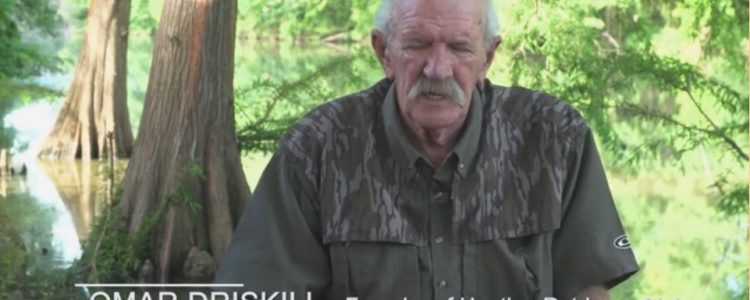
People have relied on their dogs for help retrieving game for many years. Probably many, many, many years.
As often happens when people get together, they’re compelled to see which dog is better. Thus the birth of competitive field trials.
But not everyone has the time, money, or desire to compete in field trials. However they sure do like to show off what their huntin’ dawgs can do! And so began the Hunting Retriever Club.
The birth of the Hunting Retriever Club
“Conceived by Hunters for Hunters” became the motto of the HRC. Judges strive to set up realistic hunting scenarios with duck calls and camo, real birds and handlers shooting shotguns (albeit with blanks).
Omar Driskill, Richard Walters and Bill Tarrant are some of the men instrumental in the founding of retriever hunting tests and the HRC.
I was lucky to be able to run my first HRC test under Omar and still have the ribbon he awarded my dog!
Watch the video to learn some history of retriever sports in general and the beginning of the Hunting Retriever Club in particular. I especially like the comment someone made about misnaming the Started stake. See if you can catch what he thought Started should have been called!
(Header image and video courtesy of the Hunting Retriever Club Inc.)

